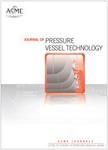版权所有:内蒙古大学图书馆 技术提供:维普资讯• 智图
内蒙古自治区呼和浩特市赛罕区大学西街235号 邮编: 010021

作者机构:IDMEC Polo FEUP UCVE P-4200465 Oporto Portugal Univ Tras Os Montes & Alto Douro Sch Sci & Technol UCVE IDMEC P-5001801 Quinta De Prados Vila Real Portugal Univ Porto Fac Engn P-4200465 Oporto Portugal
出 版 物:《JOURNAL OF PRESSURE VESSEL TECHNOLOGY-TRANSACTIONS OF THE ASME》 (J Pressure Vessel Technol Trans ASME)
年 卷 期:2011年第133卷第6期
页 面:061207页
核心收录:
学科分类:08[工学] 0807[工学-动力工程及工程热物理] 0802[工学-机械工程]
主 题:fatigue notched plate variable amplitude loading finite element method elastoplastic analysis
摘 要:Although intensive research has been carried out to understand the fatigue behavior of steel notched components, under variable amplitude loading, no definite and general robust models have been derived so far. Therefore, every effort to augment the knowledge in this topic is welcomed. Within this context, existing variable amplitude data, derived by the authors for a notched low carbon pressure vessel steel (P355NL1) flat plate, is used to assess a local approach to fatigue. A linear damage summation framework, supported by elastoplastic finite element analyses, is used. Several variable amplitude loadings were selected and analyzed, using alternative configurations of kinematic hardening plasticity models (e.g., Chaboche s model with distinct constants superposition). The predictions are assessed using available experimental data and data derived with simplified empirical elastoplastic tools. This paper highlights the difficulties of performing such elastoplastic analysis and compares the obtained results with those obtained using more classical tools for elastoplastic analysis (Glinka and Seeger-Heuler). It was found that fatigue predictions based on an elastoplastic finite element analysis, made using the Chaboche s model, were significantly more accurate than predictions based on simplified elastoplastic analysis. These results have important practical relevance. [DOI: 10.1115/1.4004617]